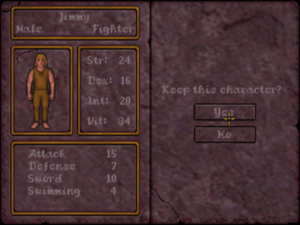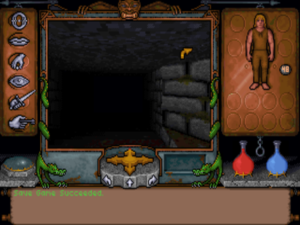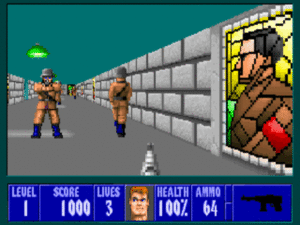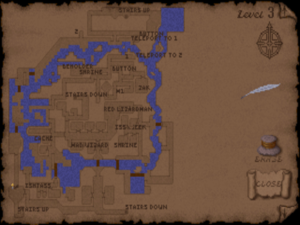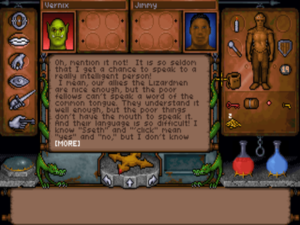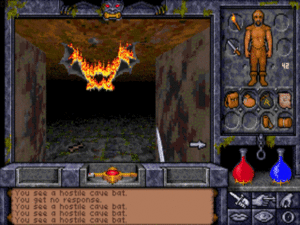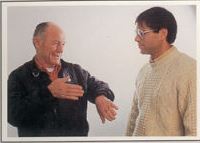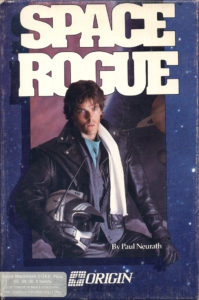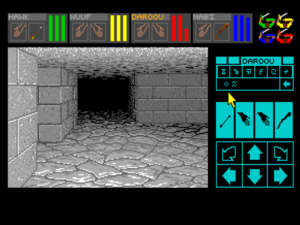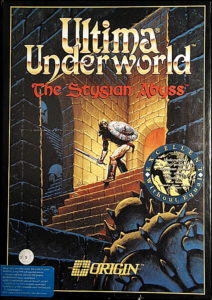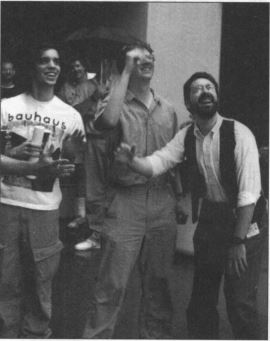I rarely play or even see current games; the demands of this historical project of mine simply don’t allow for it. Thankfully, though, being a virtual time traveler does have its advantages. Just when I’m starting to feel a little sorry for myself, having heard about some cool new release I just don’t have time for, I get to experience a game like Ultima Underworld the way a player from its own time would have seen it, and suddenly living in my bubble is worth it.
It really is difficult to convey to non-time travelers just how amazing Ultima Underworld was back in March of 1992. To be able to move freely through a realistically rendered 3D space; to be able to walk up and down inclines, to jump over or into chasms, even to swim in underground streams… no one had ever seen anything like it before. At a stroke, it transformed the hoary old CRPG formula from a cerebral exercise in systems and numbers into an organic, embodied virtual reality. In time, it would prove itself to have been the starting point of a 3D Revolution in gaming writ large, one that would transform the hobby almost beyond recognition by the end of the 1990s. We live now in a gaming future very different from the merger of Silicon Valley and Hollywood which was foreseen by the conventional wisdom of 1992. Today, embodied first-person productions, focusing on emergent experience at least as much as scripted content, dominate across a huge swathe of the gaming landscape. And the urtext of this 3D Future through which we are living is Ultima Underworld.
Given what an enormous technological leap it represented in its day, it feels almost unfair to expect too much more than that out of Ultima Underworld as a game. After all, Blue Sky Productions was working here with a whole new set of affordances, trying to figure out how to put them together in a compelling way. It seems perfectly reasonable to expect that the craftspeople of game design, at Blue Sky and elsewhere, would need a few iterations to start turning all this great new technology into great games.
But it’s in fact here that Ultima Underworld astounds perhaps most of all. This very first example of a free-scrolling 3D dungeon crawl is an absolute corker of a game design; indeed, it’s arguably never been comprehensively bettered within its chosen sub-genre. In almost every one of the many places where they were faced with a whole array of unprecedented design choices, Blue Sky chose the right one. Ultima Underworld is a game, in other words, of far more than mere historical interest. It remains well worth learning to overlook the occasional graphical infelicities of its fairly primitive 3D engine in order to enjoy the wonderful experience that still awaits underneath them.
Needless to say, this isn’t quite the norm among such radically pioneering games. Yet it is a trait which Ultima Underworld shares with the two great earlier pioneers in the art of the dungeon crawl, Wizardry and Dungeon Master. Those games too emerged so immaculately conceived that the imitators which followed them could find little to improve upon beyond their audiovisuals. Just what is it about this particular style of game that yields such success right out of the gate? Your guess is as good as mine.
Regardless, we really should take the time to look at Ultima Underworld‘s gameplay still more closely than we have up to this point. So, today, I’d like to take you on a little tour of the most groundbreaking game of 1992.
Ultima Underworld puts its most conventional foot forward first. After the conventionally horrid introductory movie, it asks us to create a character, choosing from the usual collection of classes, abilities, and skills. The only thing here that might bring a raised eyebrow to the jaded CRPG player is the demand that we specify our character’s handedness — the first clear indication that this is going to be a much different, more embodied experience than the norm.
As soon as we begin the game proper, however, all bets are off. This looks and feels like no CRPG before it. The grid has disappeared from its dungeon; we can move smoothly and freely in real time, just as if we were really inside its world.
Which isn’t to say that Blue Sky didn’t have to make compromises to bring this free-scrolling 3D environment to life using 1992-vintage hardware. I already discussed one of the compromises in my previous article: the use of affine texture mapping rather than a more rigorous algorithm. This allows the game to render its graphics much faster than it would otherwise be able to, at the expense of a slight wonkiness that afflicts the rendering engine in some situations much more than in others. The second compromise is even more obvious: the actual first-person view fills less than half of the total screen real estate. Simply put, fewer pixels to render means that the rendering can happen that much faster.
Of course, virtually every game ever made is at bottom a collection of compromises with the ideal in a designer’s head. Blue Sky made these two specific ones because they weren’t willing to compromise in other areas. Two months after Ultima Underworld was released, id Software released Wolfenstein 3D, the other great 3D pioneer of 1992. It features a first-person view that fills much more of the screen than that of Ultima Underworld, and with a considerably faster frame rate on identical hardware to boot. But its world is far less interactive. Its levels are all just that — entirely flat — and it won’t even let you look up or down. These were compromises which Blue Sky wasn’t willing to make. A commitment to verisimilitudinous simulation is the dominant theme of Ultima Underworld‘s design. It would go on to become the attribute that, more than any other, distinguishes the games of their later incarnation, Looking Glass Technologies, from the “just run and shoot” approach of id.
In light of the ubiquity of first-person 3D games in the decades since Ultima Underworld, it’s worth examining Blue Sky’s approach to controlling such a game, formulated well before any norms for same had been set in stone. Unlike what followed it, Ultima Underworld‘s preferred approach uses the mouse for everything; this was very much in line with the conventional wisdom of its era, which privileged the relatively new and friendly affordance of the mouse over the keyboard to such an extent that most games used the latter, if they used it at all, only for optional shortcuts. Thus in Ultima Underworld, you move around the world by moving the mouse into the view area and clicking as the cursor changes shape to indicate the direction of travel or rotation.
Blue Sky’s control scheme is a little different from what we may be used to, but it’s not necessarily worse. In fact, the use of the mouse in lieu of the more typical “WASD” keyboard controls for movement has at least one rather lovely advantage: moving the mouse pointer further in a given direction causes you to move faster. The WASD setup, in which each key can only be on or off at any given time, allows for no such sliding scale of movement speed, forcing clumsier solutions like another binary toggle on the keyboard for “run.”
If you just can’t deal with Ultima Underworld‘s preferred movement scheme, however, there are alternatives — always a sign of a careful, thought-through design. You can click directly on the little gray movement buttons down there below the view window. Or, in what was something of a last-minute addition, you can actually using the keyboard in a way very similar to what you may be used to from more recent games. Here, though, the WASD scheme is replaced with SADX, with the “W” key serving as the run toggle. The difference drives some modern players crazy, but it really needn’t do so. Try to get used to moving using only the mouse; you might be surprised at how well it works. (It’s worth noting as well that even id wouldn’t arrive at the WASD standard for quite some time after Ultima Underworld and Wolfenstein 3D. As late as 1993’s DOOM, they would still be mapping the arrow keys to movement by default.)
While left-clicking in the view window lets you move around, right-clicking allows you to manipulate the environment. The vertical row of icons to the left of the view window lets you choose a verb: “talk,” “take,” “examine,” “fight,” or “use,” with the topmost icon leading to the utility menu. If no icon is explicitly selected at a given point, the game intuits a default action when we right-click something in the environment. The end of the short video snippet above shows how elegantly this works in practice. We notice a message scrawled on the wall, and simply right-click it to do the most reasonable thing: to read it.
The video above gives a further taste of the interface in action. Note the ability, so conspicuously absent in id’s contemporaneous games, to look up and down as we move through the world and interact with it. This is accomplished via an exception to the mouse-centric approach. It’s only a little awkward: the “3” key shifts the view upward, “2” centers it vertically, and “1” shifts it downward. It would be at least a couple of years after Ultima Underworld‘s release before any other 3D engine would offer this capability.
This video also illustrates the game’s “paper doll” interface in action, as we pick up objects from the environment and move them into our inventory. The paper doll itself wasn’t new to Ultima Underworld; it had been pioneered by Dungeon Master and long since picked up by the main-line Ultima engines among others. This implementation of it, however, does Dungeon Master one better by living entirely on the main gameplay screen. Indeed, the game has no other screens, with just one exception which we’ll get to momentarily; its commitment to a mode-less interface is even more complete than was Dungeon Master‘s. This, one might even say, is the hidden benefit of that constrained view window. Everything that surrounds it is necessary; the view window might be small, but there is no wasted space anywhere else on the screen. Even what might seem, judging only from the videos above, to be small areas with no purpose actually aren’t, as further playing will reveal. The gray area to the left of the compass will tell us what magical status effects are active; the shelf to the right of the compass is where we will build spells using runes; the crystal at far left, just below the icon bar, shows our current attack strength, and is thus vital for combat. The fact that you aren’t constantly moving between screens does much to enhance the all-pervasive sense that you are there in the dungeon.
Equally important for this effect is a general disinterest in using numbers to represent the current status of your character — or, perhaps better said in light of the game’s commitment to embodiment, your status. While numbers do appear in places — especially if you go looking for them — they’re nowhere near as prevalent as they are in most contemporaneous CRPGs. Your health and mana levels, for instance, are represented graphically by the red and blue vials on the bottom right of the screen — this being another part of the screen you might have initially assumed to be decoration, but which is actually vital.
Later in the video above, we fire up a torch, shedding some welcome light on our surroundings and showing off the game’s advanced lighting model. At the risk of beating a dead horse, I must say, yet again, that no other game of Ultima Underworld’s era or for some time thereafter could match the latter.
Finally, we see something of the game’s physics model in action, as we toss a (useless) skull against the wall. Such kinetic, tactile responsiveness is a far cry from most CRPGs, even as the strength of your character’s throw is indeed affected by his statistics. Dungeon Master, that critical way station beyond Wizardry and Ultima Underworld, pioneered some of this more kinetic approach, but the free-scrolling environment here allows the game to use it that much more effectively.
In addition to the torch, we found in that first sack the game’s auto-map. Even as its presence as a physical object in the world emphasizes the game’s ongoing commitment to embodiment, this is actually the only place where the game’s commitment to its mode-less interface falters — but what a spectacular exception it is! I’ve cheated a bit with the screenshot above, choosing a point from much deeper in the game in order to show the auto-map in its full glory. It’s a feature that simply has to be here; the rest of the game, remarkable as it is, would fall apart without it. Cartography — making your own maps on reams of graph paper — had been a standard part of the dungeon-crawl experience prior to Ultima Underworld. Even real-time dungeon crawls like Dungeon Master had left mapping to the player. By removing the discrete grid, however, Ultima Underworld made this style of mapping, if not utterly impossible, at least far too difficult to be any fun even for the dedicated graph-paper-and-pencil crowd. An auto-map was as fundamental to its design as anything in the game.
But if an auto-map of some sort was essential, it certainly wasn’t necessary for its implementation to be this absurdly fantastic. Dan Schmidt, one of the Ultima Underworld developers, has said on several occasions that he considers the seemingly plebeian affordance of the auto-map to be the most impressive single thing in a game that’s bursting at the seams with unprecedented features. There are days when I find myself agreeing.
Whilst ditching the need for graph paper and pencil, Ultima Underworld preserves the foremost pleasure of CRPG cartography: that of seeing all of the blank spaces on your map filled in, enjoying the gradual transformation of the chaotic unknown into the orderly known. The map of each level is lovely to look at as it takes shape. You want to visit every nook and cranny on each one of the levels just to make it as pristine and complete as possible. You’ll even swim the length of the underground streams and lakes, if that’s what it takes to get them completely documented on parchment.
And there’s one final thing the auto-map does which few games — few games ever, mind you — can match: you can make your own notes on the thing, wherever and whenever you want to. Did you notice all of the text on the map above? I did that, not the game. Needless to say, the programming needed to accommodate this — which, incidentally, had already been completed by Doug Church and J.D. Arnold before the rest of the Blue Sky programming team even arrived — couldn’t have been easy. In terms of both design and implementation, Ultima Underworld‘s auto-map really is nothing short of spectacular.
In the video above, we move down the corridor from the game’s starting point. Notice again how we can move slower or faster merely by shifting the position of the mouse within the view window.
We find our first door at the end of the corridor. This door can be opened by a pull chain just beside it, but we rather perversely elect to close it again and then bash it open. Our ability to do so serves as a further illustration of Blue Sky’s commitment to simulation and emergence. The main-line Ultima games as well have doors of variable strength, but, as any dedicated player of those games quickly realizes, Origin Systems had a tendency to cheat in order to fill the needs of a plot that got steadily more complex from installment to installment: many doors — the plot-important doors — are indestructible. You need the correct key to open them, whose acquisition ensures that certain bits of plot are seen before other bits. (As Ron Gilbert once put it, heavily narrative-focused game design ultimately all tends to come down to locks and keys of a literal or metaphorical stripe.)
But Blue Sky, who don’t have the same sort of elaborate pre-crafted plot full of important story beats to worry about, never cheats. Any given door may indeed have a key which you can find, but, if you haven’t found the key, it is at least theoretically possible to pick its lock, to open it using a magic spell, or to simply bash it down. Mind you, doing the last may not do your weapon any favors; keen sword blades were not made to chop through wood. Here we have yet another example of the game’s focus on simulation, albeit one that may feel somewhat less welcome in practical terms than it does in the abstract when your poor misused sword breaks at an inopportune moment — like, say, in the midst of a desperate combat.
The game’s magic system is marked by the same sense of embodied physicality as everything else. Before you can cast spells at all, you’ll need to find a rune bag helpfully left behind by one of the dungeon’s unfortunate earlier explorers. For a long time to come, you’ll be collecting runes to put in it. You combine these runes into “recipes” — most of which are found in the manual — in order to cast spells. In the video above, we place two recently discovered runes into our rune bag and then cast a light spell which can serve as a handy replacement for a torch. (Note that it takes a couple of tries to successfully cast the spell, a sign of our character’s inexperience.) All character classes can use magic to a greater or lesser degree. Even an otherwise “pure” fighter will probably find simple spells that obviate the need to cart around torches or food to be very useful indeed. Thanks to magic, there’s no time limit on the game in the form of depleting resources; by the time you’ve scarfed up all the food in the dungeon, you’ll have long since mastered the “create food” spell.
The rune-based magic system is another aspect of Ultima Underworld that smacks of Dungeon Master (as is, for that matter, the flexible character-development system in which any character can learn to do anything with enough time and effort). But the Blue Sky team has denied looking closely to the older game for inspiration, and we have no reason to doubt their word. So, we’ll have to chalk the similarities up to nothing more than the proverbial great minds thinking alike. If anything, Ultima Underworld‘s magic system is even more elegant than its predecessor’s. Because you’re collecting physical runes, rather than mere spell recipes in the form of scrolls as in Dungeon Master, the sense that everything that matters to the game is an embodied thing in the world is that much more pronounced here.
It should come as no surprise by this point that Ultima Underworld‘s combat system is built along the same lines of embodied physicality. That is to say, you physically swing (or shoot, or throw) your weapon against monsters that are embodied in the same space as you. The video above gives a taste of this, in the form of a battle against a giant rat guarding some choice booty. (Ultima Underworld may be a breathtakingly original design, but some things in the world of CRPGs are timeless. Meeting giant rats as your first opponents is among these.)
Later battles will see you using the environment in all sorts of creative ways: shooting down upon monsters from ledges, blasting them with magic and then running away to recharge your batteries behind a closed door. You can also try to sneak past monsters you’d rather not fight, using not only your character’s innate stealth ability but your own skill at maneuvering through light and shadow. In fact, a sufficiently dedicated pacifist could finish Ultima Underworld while doing surprisingly little killing at all. One of the advantages of the simulation-first approach is that it really does let you play the game your way — possibly even in ways that the game’s designers never thought of.
But Ultima Underworld isn’t all emergent simulation. It does have a plot of sorts, albeit one that you can approach in your own way, at your own speed, and in your own order. You learn soon after arriving in the dungeon that you need to assemble a collection of magic objects. Doing so will occupy your attention for the bulk of the game.
This scavenger-hunt structure may be less innovative than most of the game, but it’s executed with considerable verve. Each level has its own personality and its own inhabitants, living in what feel like credible communities. Importantly, you don’t — or shouldn’t, anyway — indiscriminately slaughter your way through the levels. You need to talk to others, an element that’s notably missing from Wizardry and Dungeon Master. The dungeon’s inhabitants actually remember your treatment of them. An early example of the game’s relationship model, if you will, is provided on the very first level. Two tribes of goblins who hate one another live there in an uneasy symbiosis. Will you ally yourself with one or the other? Or will you try to thread the needle between friend and foe with both, or for that matter go to war with both? The choice is up to you. But choose carefully, for such choices in this game have consequences which you will be living with for a long time to come.
Regular readers of this blog are doubtless aware that I place a high premium on fairness and solubility in games. I’ve gone on record many times saying that a game which is realistically soluble only through a walkthrough cannot by definition be a good game, no matter what other things it does well. In this context, everything would seem to be working against Ultima Underworld. A bunch of MIT whiz kids, all freelancing without recourse to any central design authority, working in an insular environment without recourse to outside play testers… it doesn’t give one much hope for fair puzzles.
Yet, here as in so many other places, Ultima Underworld defies my prejudices and expectations alike. There are perhaps two or three places where the clues could stand to be a little more explicit — certainly no one should feel ashamed to peek at a walkthrough when playing — but there are no egregious howlers here. Take careful notes, take your time, and follow up diligently on all of the clues, and there’s no reason that you can’t solve this one for yourself. Sure, by modern standards it’s an absurdly difficult game. There is no quest log to keep everything neat and tidy for you, and, as a byproduct of its ethos of respecting and empowering its player at every turn, the game will happily let you toss essential quest items into a river, never to be seen again, without saying a word about it. At the same time, though, the utter lack of guardrails can be bracing. If you solve this one, you’ve really accomplished something. And, unlike so many of the games I’ve complained about on this blog, Ultima Underworld never feels like it’s trying to screw you over. It just won’t prevent you from doing so if you decide to screw yourself over.
Only occasionally does the commitment to simulation get in the way of friendly, fair design. To wit: after talking to a character once, trying to elicit the same information again often results only in some variation on “I already told you that!” Dan Schmidt, who was responsible for pulling all of the dialog together, told me that he believed at the time that this was only fair, another way of committing to verisimilitude in all things. Nowadays, I (and he) are more likely to categorize it under that heading of design failures known as “the designer being a jerk just because he can.” Given what a masterpiece Ultima Underworld is on the whole, it’s almost comforting to know that Blue Sky still had a few things to learn about good design.
On the other hand, I really love the way the design uses the game’s virtual space. There are a considerable number of quests and puzzles that span multiple levels in the dungeon, forcing you to retrace your steps and revisit “finished” levels. Another of Ultima Underworld‘s more unique design decisions in comparison with the dungeon-crawl tradition, this does much to give the game a holistic feel, making its dungeon feel like a living place rather than just a series of levels to be solved one after another.
The puzzles themselves are as mode-less as the basic interface. None of them pull you out of the game’s world: no riddles, no mini-games. Instead they work brilliantly within it. There are some wonderfully rewarding puzzles here, such that I hate to spoil them by saying too much about them. Following up on the clues you’re given, you’ll do things that seem like they couldn’t possibly work — surely the game engine can’t be that granularly responsive! — and be shocked and delighted when they actually do. In one fine example, you’ll have to literally learn a new language — okay, a limited subset of it anyway — via clues scattered around the environment. Sometimes challenging and often complex but never unfair, the puzzles will richly reward the effort you put into them.
Perhaps the best example of how the puzzles of Ultima Underworld are integrated into its environment is Garamon, a mysterious personage who often visits your dreams when you sleep. He at first seems like nothing more than a contrived adventure-game clue dispenser, but you gradually realize that he is a real — albeit deceased! — character in the story of the Abyss, and that he has something very personal he wants you to do for him: to give his body a proper burial so he can find peace. When you discover a certain empty tomb, and connect it with the figure from your dreams, the flash of insight is downright moving.
I could go on with yet more praise for Ultima Underworld — praise for, by way of example, its marvelous context-sensitive music, provided by the prolific game composers George “The Fat Man” Sanger and Dave Govett (also the composers of the Wing Commander score among many, many others). Yet I hesitate to cause what may already seem like an overly effusive review to read still more so. I can only hope that my reputation as a critic not overly prone to hyperbole will precede me here when I say that this game truly is a sublime achievement.
I have less — and far less that is positive — to say about the second and final Ultima Underworld game, which bears the subtitle Labyrinth of Worlds. In contrast to its groundbreaking predecessor, it’s a fairly typical sequel, offering as its only mechanical or technical innovation a somewhat larger view window on the 3D environment. Otherwise, it’s more of the same, only much bigger, and not executed quite as well.
The new entity that was known as Looking Glass Technologies — the product of the merger between Blue Sky Productions and Lerner Research — became a much more integral part of the Origin Systems family after the first Ultima Underworld‘s release and commercial success. The result was a plot for the new game that was also better integrated into the Ultima timeline, falling between the two games made by Origin themselves with their own Ultima VII engine in terms of both plot and release chronology. The new interest in set-piece plotting and Ultima lore does the sequel few favors; it rather straitjackets the sense of free-form exploration and discovery that marks the original. Instead of being confined to a single contiguous environment, Ultima Underworld II sends you hopscotching back and forth through its titular “labyrinth of worlds.” The approach feels scattershot, and the game is far less soluble than its predecessor — yet another proof of a theorem which the games industry could never seem to grasp: that a bigger game is not necessarily a better game.
The sequel was created from start to finish in less than nine months, nearly killing the team responsible for it. Origin and Looking Glass’s desire to get a second game out the door is understandable on the face of it; they had a hit on their hands, and wanted to strike while the iron was hot. This they certainly did, but the sequel reportedly sold less than half as many copies as its predecessor — although it should also be noted that even those numbers were enough to qualify it as a major hit by contemporary standards. Still, Paul Neurath, the head of Blue Sky and co-head of Looking Glass, has expressed regret that he didn’t give his people permission and time to make something more formally ambitious. In the future, Looking Glass would generally avoid these sorts of quickie sequels.
While the second game is probably best reserved for the CRPG hardcore and those who just can’t get enough of the experience provided by the first one, the original Ultima Underworld is a must-play. Without a doubt one of the very best CRPGs ever made, it’s even more important for the example it set for gaming in general, showing what heights of flexibility and player-responsiveness could be scaled through the emerging medium of 3D graphics. The pity is that more developers — even many of those who eventually went 3D — didn’t heed the entirety of its example. Countless later games would improve on Ultima Underworld‘s sometimes wonky visuals by throwing out its simplistic affine texture mapping in favor of better techniques, and by blowing up its view window to fill the whole screen. Very few of them, however, would demonstrate the same commitment to what Blue Sky/Looking Glass saw as the real potential of 3D graphics: that of simulating an intuitively emergent world and placing you, the player, inside it. Whether judged in terms of historical importance or by the more basic metric of how much fun it still is to play, Ultima Underworld is and will always remain seminal.
(Ultima Underworld I and II can be purchased from GOG.com.)
